Ying Wang
KernelEvolve: Scaling Agentic Kernel Coding for Heterogeneous AI Accelerators at Meta
Dec 30, 2025Abstract:Making deep learning recommendation model (DLRM) training and inference fast and efficient is important. However, this presents three key system challenges - model architecture diversity, kernel primitive diversity, and hardware generation and architecture heterogeneity. This paper presents KernelEvolve-an agentic kernel coding framework-to tackle heterogeneity at-scale for DLRM. KernelEvolve is designed to take kernel specifications as input and automate the process of kernel generation and optimization for recommendation model across heterogeneous hardware architectures. KernelEvolve does so by operating at multiple programming abstractions, from Triton and CuTe DSL to low-level hardware agnostic languages, spanning the full hardware-software optimization stack. The kernel optimization process is described as graph-based search with selection policy, universal operator, fitness function, and termination rule, dynamically adapts to runtime execution context through retrieval-augmented prompt synthesis. We designed, implemented, and deployed KernelEvolve to optimize a wide variety of production recommendation models across generations of NVIDIA and AMD GPUs, as well as Meta's AI accelerators. We validate KernelEvolve on the publicly-available KernelBench suite, achieving 100% pass rate on all 250 problems across three difficulty levels, and 160 PyTorch ATen operators across three heterogeneous hardware platforms, demonstrating 100% correctness. KernelEvolve reduces development time from weeks to hours and achieves substantial performance improvements over PyTorch baselines across diverse production use cases and for heterogeneous AI systems at-scale. Beyond performance efficiency improvements, KernelEvolve significantly mitigates the programmability barrier for new AI hardware by enabling automated kernel generation for in-house developed AI hardware.
DS-HGCN: A Dual-Stream Hypergraph Convolutional Network for Predicting Student Engagement via Social Contagion
Dec 23, 2025Abstract:Student engagement is a critical factor influencing academic success and learning outcomes. Accurately predicting student engagement is essential for optimizing teaching strategies and providing personalized interventions. However, most approaches focus on single-dimensional feature analysis and assessing engagement based on individual student factors. In this work, we propose a dual-stream multi-feature fusion model based on hypergraph convolutional networks (DS-HGCN), incorporating social contagion of student engagement. DS-HGCN enables accurate prediction of student engagement states by modeling multi-dimensional features and their propagation mechanisms between students. The framework constructs a hypergraph structure to encode engagement contagion among students and captures the emotional and behavioral differences and commonalities by multi-frequency signals. Furthermore, we introduce a hypergraph attention mechanism to dynamically weigh the influence of each student, accounting for individual differences in the propagation process. Extensive experiments on public benchmark datasets demonstrate that our proposed method achieves superior performance and significantly outperforms existing state-of-the-art approaches.
PMB-NN: Physiology-Centred Hybrid AI for Personalized Hemodynamic Monitoring from Photoplethysmography
Dec 11, 2025Abstract:Continuous monitoring of blood pressure (BP) and hemodynamic parameters such as peripheral resistance (R) and arterial compliance (C) are critical for early vascular dysfunction detection. While photoplethysmography (PPG) wearables has gained popularity, existing data-driven methods for BP estimation lack interpretability. We advanced our previously proposed physiology-centered hybrid AI method-Physiological Model-Based Neural Network (PMB-NN)-in blood pressure estimation, that unifies deep learning with a 2-element Windkessel based model parameterized by R and C acting as physics constraints. The PMB-NN model was trained in a subject-specific manner using PPG-derived timing features, while demographic information was used to infer an intermediate variable: cardiac output. We validated the model on 10 healthy adults performing static and cycling activities across two days for model's day-to-day robustness, benchmarked against deep learning (DL) models (FCNN, CNN-LSTM, Transformer) and standalone Windkessel based physiological model (PM). Validation was conducted on three perspectives: accuracy, interpretability and plausibility. PMB-NN achieved systolic BP accuracy (MAE: 7.2 mmHg) comparable to DL benchmarks, diastolic performance (MAE: 3.9 mmHg) lower than DL models. However, PMB-NN exhibited higher physiological plausibility than both DL baselines and PM, suggesting that the hybrid architecture unifies and enhances the respective merits of physiological principles and data-driven techniques. Beyond BP, PMB-NN identified R (ME: 0.15 mmHg$\cdot$s/ml) and C (ME: -0.35 ml/mmHg) during training with accuracy similar to PM, demonstrating that the embedded physiological constraints confer interpretability to the hybrid AI framework. These results position PMB-NN as a balanced, physiologically grounded alternative to purely data-driven approaches for daily hemodynamic monitoring.
IF-Bench: Benchmarking and Enhancing MLLMs for Infrared Images with Generative Visual Prompting
Dec 10, 2025Abstract:Recent advances in multimodal large language models (MLLMs) have led to impressive progress across various benchmarks. However, their capability in understanding infrared images remains unexplored. To address this gap, we introduce IF-Bench, the first high-quality benchmark designed for evaluating multimodal understanding of infrared images. IF-Bench consists of 499 images sourced from 23 infrared datasets and 680 carefully curated visual question-answer pairs, covering 10 essential dimensions of image understanding. Based on this benchmark, we systematically evaluate over 40 open-source and closed-source MLLMs, employing cyclic evaluation, bilingual assessment, and hybrid judgment strategies to enhance the reliability of the results. Our analysis reveals how model scale, architecture, and inference paradigms affect infrared image comprehension, providing valuable insights for this area. Furthermore, we propose a training-free generative visual prompting (GenViP) method, which leverages advanced image editing models to translate infrared images into semantically and spatially aligned RGB counterparts, thereby mitigating domain distribution shifts. Extensive experiments demonstrate that our method consistently yields significant performance improvements across a wide range of MLLMs. The benchmark and code are available at https://github.com/casiatao/IF-Bench.
A digital SRAM-based compute-in-memory macro for weight-stationary dynamic matrix multiplication in Transformer attention score computation
Nov 15, 2025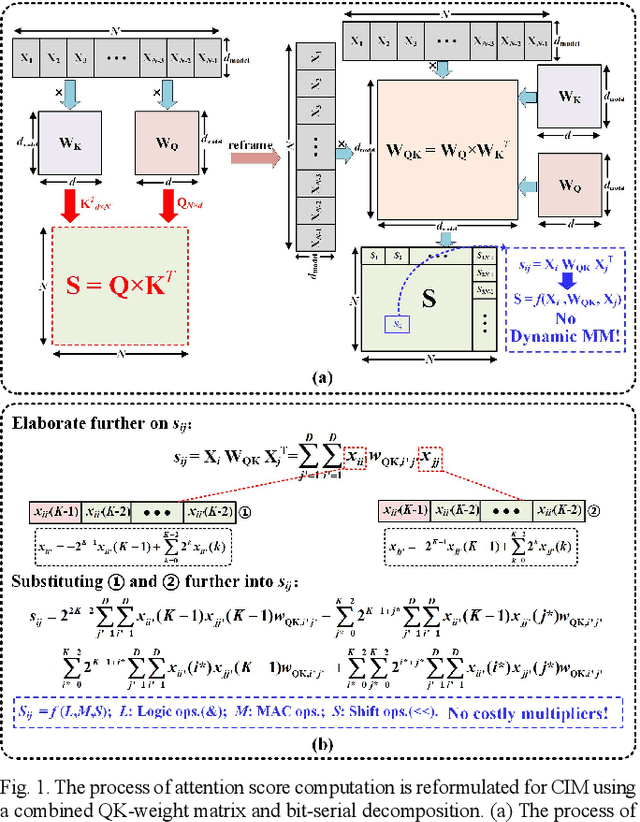
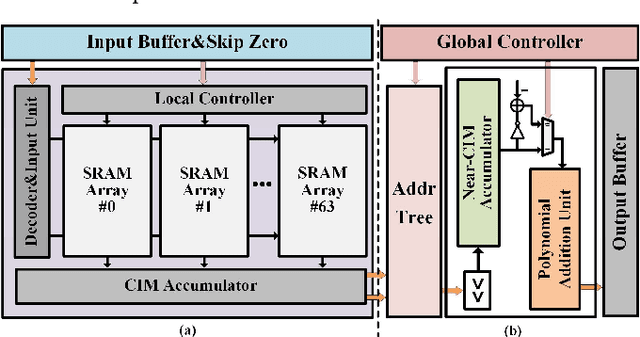


Abstract:Compute-in-memory (CIM) techniques are widely employed in energy-efficient artificial intelligent (AI) processors. They alleviate power and latency bottlenecks caused by extensive data movements between compute and storage units. This work proposes a digital CIM macro to compute Transformer attention. To mitigate dynamic matrix multiplication that is unsuitable for the common weight-stationary CIM paradigm, we reformulate the attention score computation process based on a combined QK-weight matrix, so that inputs can be directly fed to CIM cells to obtain the score results. Moreover, the involved binomial matrix multiplication operation is decomposed into 4 groups of bit-serial shifting and additions, without costly physical multipliers in the CIM. We maximize the energy efficiency of the CIM circuit through zero-value bit-skipping, data-driven word line activation, read-write separate 6T cells and bit-alternating 14T/28T adders. The proposed CIM macro was implemented using a 65-nm process. It occupied only 0.35 mm2 area, and delivered a 42.27 GOPS peak performance with 1.24 mW power consumption at a 1.0 V power supply and a 100 MHz clock frequency, resulting in 34.1 TOPS/W energy efficiency and 120.77 GOPS/mm2 area efficiency. When compared to the CPU and GPU, our CIM macro is 25x and 13x more energy efficient on practical tasks, respectively. Compared with other Transformer-CIMs, our design exhibits at least 7x energy efficiency and at least 2x area efficiency improvements when scaled to the same technology node, showcasing its potential for edge-side intelligent applications.
Radar-APLANC: Unsupervised Radar-based Heartbeat Sensing via Augmented Pseudo-Label and Noise Contrast
Nov 11, 2025Abstract:Frequency Modulated Continuous Wave (FMCW) radars can measure subtle chest wall oscillations to enable non-contact heartbeat sensing. However, traditional radar-based heartbeat sensing methods face performance degradation due to noise. Learning-based radar methods achieve better noise robustness but require costly labeled signals for supervised training. To overcome these limitations, we propose the first unsupervised framework for radar-based heartbeat sensing via Augmented Pseudo-Label and Noise Contrast (Radar-APLANC). We propose to use both the heartbeat range and noise range within the radar range matrix to construct the positive and negative samples, respectively, for improved noise robustness. Our Noise-Contrastive Triplet (NCT) loss only utilizes positive samples, negative samples, and pseudo-label signals generated by the traditional radar method, thereby avoiding dependence on expensive ground-truth physiological signals. We further design a pseudo-label augmentation approach featuring adaptive noise-aware label selection to improve pseudo-label signal quality. Extensive experiments on the Equipleth dataset and our collected radar dataset demonstrate that our unsupervised method achieves performance comparable to state-of-the-art supervised methods. Our code, dataset, and supplementary materials can be accessed from https://github.com/RadarHRSensing/Radar-APLANC.
MMOT: The First Challenging Benchmark for Drone-based Multispectral Multi-Object Tracking
Oct 14, 2025Abstract:Drone-based multi-object tracking is essential yet highly challenging due to small targets, severe occlusions, and cluttered backgrounds. Existing RGB-based tracking algorithms heavily depend on spatial appearance cues such as color and texture, which often degrade in aerial views, compromising reliability. Multispectral imagery, capturing pixel-level spectral reflectance, provides crucial cues that enhance object discriminability under degraded spatial conditions. However, the lack of dedicated multispectral UAV datasets has hindered progress in this domain. To bridge this gap, we introduce MMOT, the first challenging benchmark for drone-based multispectral multi-object tracking. It features three key characteristics: (i) Large Scale - 125 video sequences with over 488.8K annotations across eight categories; (ii) Comprehensive Challenges - covering diverse conditions such as extreme small targets, high-density scenarios, severe occlusions, and complex motion; and (iii) Precise Oriented Annotations - enabling accurate localization and reduced ambiguity under aerial perspectives. To better extract spectral features and leverage oriented annotations, we further present a multispectral and orientation-aware MOT scheme adapting existing methods, featuring: (i) a lightweight Spectral 3D-Stem integrating spectral features while preserving compatibility with RGB pretraining; (ii) an orientation-aware Kalman filter for precise state estimation; and (iii) an end-to-end orientation-adaptive transformer. Extensive experiments across representative trackers consistently show that multispectral input markedly improves tracking performance over RGB baselines, particularly for small and densely packed objects. We believe our work will advance drone-based multispectral multi-object tracking research. Our MMOT, code, and benchmarks are publicly available at https://github.com/Annzstbl/MMOT.
TITAN: A Trajectory-Informed Technique for Adaptive Parameter Freezing in Large-Scale VQE
Sep 18, 2025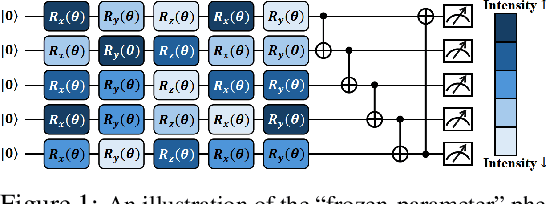
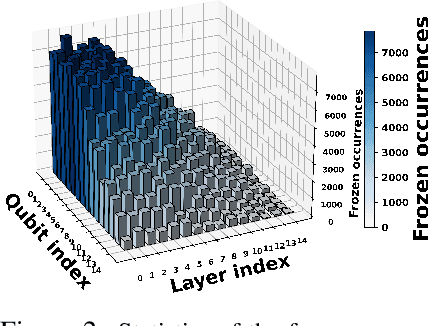
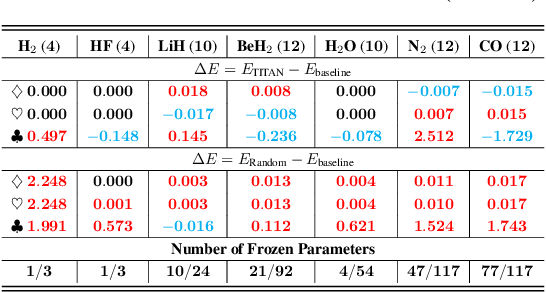
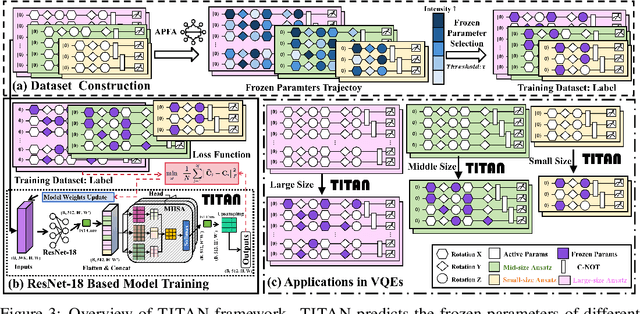
Abstract:Variational quantum Eigensolver (VQE) is a leading candidate for harnessing quantum computers to advance quantum chemistry and materials simulations, yet its training efficiency deteriorates rapidly for large Hamiltonians. Two issues underlie this bottleneck: (i) the no-cloning theorem imposes a linear growth in circuit evaluations with the number of parameters per gradient step; and (ii) deeper circuits encounter barren plateaus (BPs), leading to exponentially increasing measurement overheads. To address these challenges, here we propose a deep learning framework, dubbed Titan, which identifies and freezes inactive parameters of a given ansatze at initialization for a specific class of Hamiltonians, reducing the optimization overhead without sacrificing accuracy. The motivation of Titan starts with our empirical findings that a subset of parameters consistently has a negligible influence on training dynamics. Its design combines a theoretically grounded data construction strategy, ensuring each training example is informative and BP-resilient, with an adaptive neural architecture that generalizes across ansatze of varying sizes. Across benchmark transverse-field Ising models, Heisenberg models, and multiple molecule systems up to 30 qubits, Titan achieves up to 3 times faster convergence and 40% to 60% fewer circuit evaluations than state-of-the-art baselines, while matching or surpassing their estimation accuracy. By proactively trimming parameter space, Titan lowers hardware demands and offers a scalable path toward utilizing VQE to advance practical quantum chemistry and materials science.
Comprehensive Comparison Network: a framework for locality-aware, routes-comparable and interpretable route recommendation
Aug 12, 2025Abstract:Route recommendation (RR) is a core task of route planning in the Amap app, with the goal of recommending the optimal route among candidate routes to users. Unlike traditional recommendation methods, insights into the local quality of routes and comparisons between candidate routes are crucial for enhancing recommendation performance but often overlooked in previous studies. To achieve these, we propose a novel model called Comprehensive Comparison Network (CCN). CCN not only uses query-level features (e.g. user features) and item-level features (e.g. route features, item embedding) that are common in traditional recommendations, but also introduces comparison-level features which describe the non-overlapping segments between different routes to capture the local quality of routes. The key component Comprehensive Comparison Block (CCB) in CCN is designed to enable comparisons between routes. CCB includes a Comprehensive Comparison Operator (CCO) and a multi-scenario MLP, which can update the representations of candidate routes based on a comprehensive comparison. By stacking multiple CCBs, CCN can determine the final scores of candidate routes and recommend the optimal one to the user. Additionally, since routes directly affect the costs and risks experienced by users, the RR model must be interpretable for online deployment. Therefore, we designed an interpretable pair scoring network to achieve interpretability. Both offline and online experiments demonstrate that CCN significantly improves RR performance and exhibits strong interpretability. CCN has been fully deployed in the Amap app for over a year, providing stable and optimal benefits for route recommendations.
Physiological-Model-Based Neural Network for Heart Rate Estimation during Daily Physical Activities
Jun 11, 2025Abstract:Heart failure (HF) poses a significant global health challenge, with early detection offering opportunities for improved outcomes. Abnormalities in heart rate (HR), particularly during daily activities, may serve as early indicators of HF risk. However, existing HR monitoring tools for HF detection are limited by their reliability on population-based averages. The estimation of individualized HR serves as a dynamic digital twin, enabling precise tracking of cardiac health biomarkers. Current HR estimation methods, categorized into physiologically-driven and purely data-driven models, struggle with efficiency and interpretability. This study introduces a novel physiological-model-based neural network (PMB-NN) framework for HR estimation based on oxygen uptake (VO2) data during daily physical activities. The framework was trained and tested on individual datasets from 12 participants engaged in activities including resting, cycling, and running. By embedding physiological constraints, which were derived from our proposed simplified human movement physiological model (PM), into the neural network training process, the PMB-NN model adheres to human physiological principles while achieving high estimation accuracy, with a median R$^2$ score of 0.8 and an RMSE of 8.3 bpm. Comparative statistical analysis demonstrates that the PMB-NN achieves performance on par with the benchmark neural network model while significantly outperforming traditional physiological model (p=0.002). In addition, our PMB-NN is adept at identifying personalized parameters of the PM, enabling the PM to generate reasonable HR estimation. The proposed framework with a precise VO2 estimation system derived from body movements enables the future possibilities of personalized and real-time cardiac monitoring during daily life physical activities.
 Add to Chrome
Add to Chrome Add to Firefox
Add to Firefox Add to Edge
Add to Edge